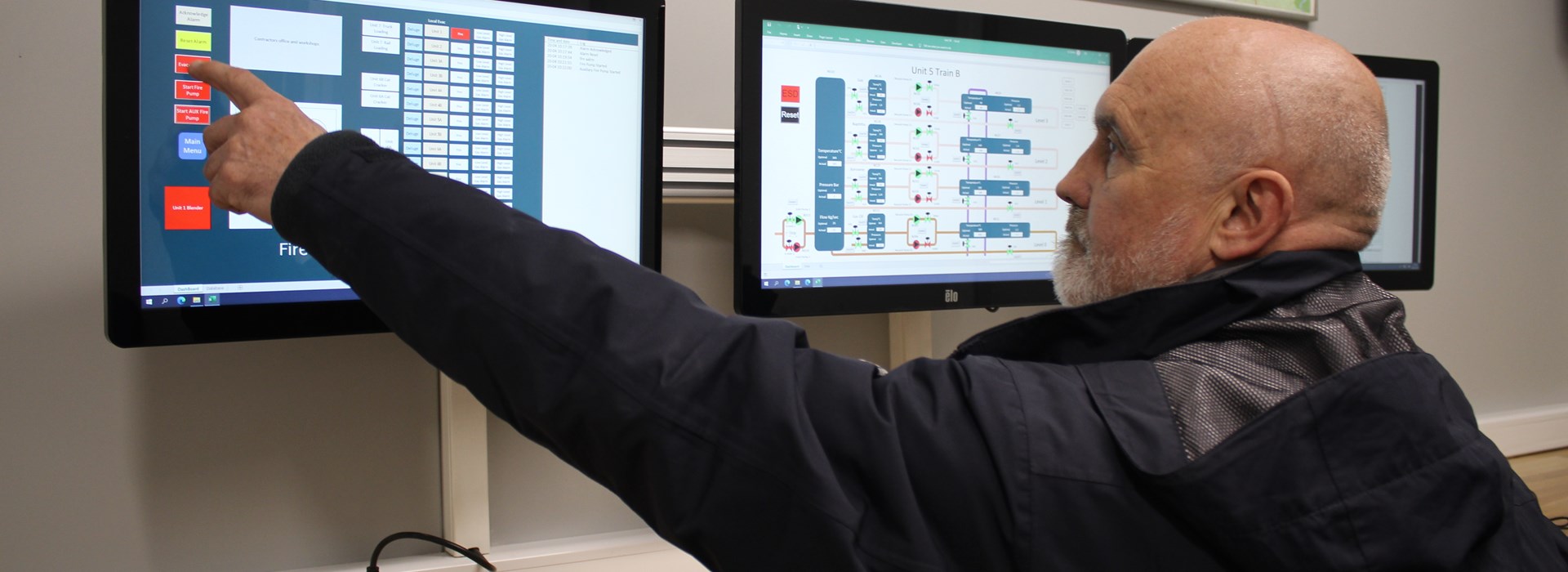Control room
The command suite is designed around the live fire simulators at our facility, but as it uses off the shelf software it can be tailored quickly to be used at a clients location. The control room has two work stations for delegates consisting of dispatch / logging facilities (ICS) and process panels where alarms or process excursions can be generated by the instructor in order to stimulate a reaction.
The instructor sits in a separate sound proofed room where he/she can manipulate the information the delegates can see. The control room has a microphone where the activities of a session can be recorded and played back during an evaluation.
The incidents can be tailored according to the clients needs. i.e. for the private petrochemical industries fires or chemical releases and for the public sectors all types of incidents from wildfires to structural fire or rescue events.
The control room can be used in conjunction with our live fire training facilities (petrochemical) to train the interaction with panel operators and response teams outside or can be done in a virtual world where the focus is placed on communication and procedural activities.
Objectives
- Train interoperability between panel operators and emergency response personnel.
- Train interoperability between emergency dispatchers and emergency response personnel.
- Train the interpersonal skills required for efficient decision making and communications during an emergency in a realistic environment
- Provide a training environment in which the Incident command system can be explored.
- A tailored procedural training for incident management , based on in company emergency response plan.
- Train all level of ICS management from single resource up to advanced incidents (ISC200 up to 400)
Dispatch station
This consists of a computer screen where the response is initiated and the events are logged. The systems can be expanded to show different levels of command and can track and manage resources.
The software depending on the incident will give useful checklists to help the operator through the incident to avoid missing a vital step in the response. This element is set up with a generic list of checks but can be tailored to suite the actual procedures of the client.
The dispatcher / logger has several communication means available, such as VHF radio, telephone and PA system. The information generated by the logger can be seen remotely by higher management teams. This system can be expanded to deal with all levels of ICS functions.
The software not only has a training aid but can be used as the primary means to document incident command system functions in a real situation.
Panel operator station
This is designed around a simple fictitious petrochemical plant configuration than requires very little time to become effective in its use but replicates the processes required to manage an incident. Consists of three touch screens which to simulate control room operations as follows:
- Fire and gas alarms panel. The instructor can manipulate the panel to give alarms on 7 process units. Fire high and low gas alarms. The delegate can interact with the screen to acknowledge the alarms, provide alarms for evaluation locally or the entire site and start up the fire fighting systems. The instructor can give error warning to give extra dilemmas for the responding operators.
- The second screen gives process schematics. Showing status of valves, pumps and process vessels. The control panels schematics are not directly connected to any process unit on the training ground but do reflect the actual situation as each process unit has been designed with a specific process flow in mind. Therefore the instructor can show temperature / pressure and flow changes to the unit. If the fire teams outside are not controlling the situation i.e. providing cooling on a specific process vessel then the instructors can replicate this on the schematic panels by showing increased temperatures and pressures. The delegate operators can turn on or off valves / switch pumps, initiate an emergency shut down and receive commands or communicate their responses with the responsible command hierarchy.
- This screen is an information hub. Gives weather information, CCTV images (actual from outside or virtual from recording), digital plans, work permits information, attendance records and links to MSDS database.
Instructor Room
The instructor and / or evaluator will sit in a room adjacent to the control room. Via a one-way viewing glass and sound system the instructors can watch and manipulate the scenario without directly interacting with the delegates. The control room will become totally isolated and will create an all inclusive experience. Alarms sounds radio traffic telephone calls as well as visual stimulus.
CMT board room
In an adjacent room a CMT setting has been created. A board room setting with large monitor which replicates information from the control room. The CMT has separate computer and software to manage and log their activities. Scenarios can be created from the initial actions of a basic incident from the control room to that which is expanding. The software has more command management options, such as command structure registration, resource management, operations period planning, safety analyse registration according to the ICS.
Backups
Digital systems are more efficient and can help enormously with the command and control, however power failures or technical issues can make things chaotic, therefore there are manual back up systems available should it be needed. Should the ICS interfaces fail then the delegates will learn how to manage the incident with these backup systems. (White boards, plans, hard copy forms etc).
More information and booking
For more information or if you want to book a course, please contact our colleagues of Business Support on: +31 181 376 666 or fireacademy@nl.relyonnutec.com


